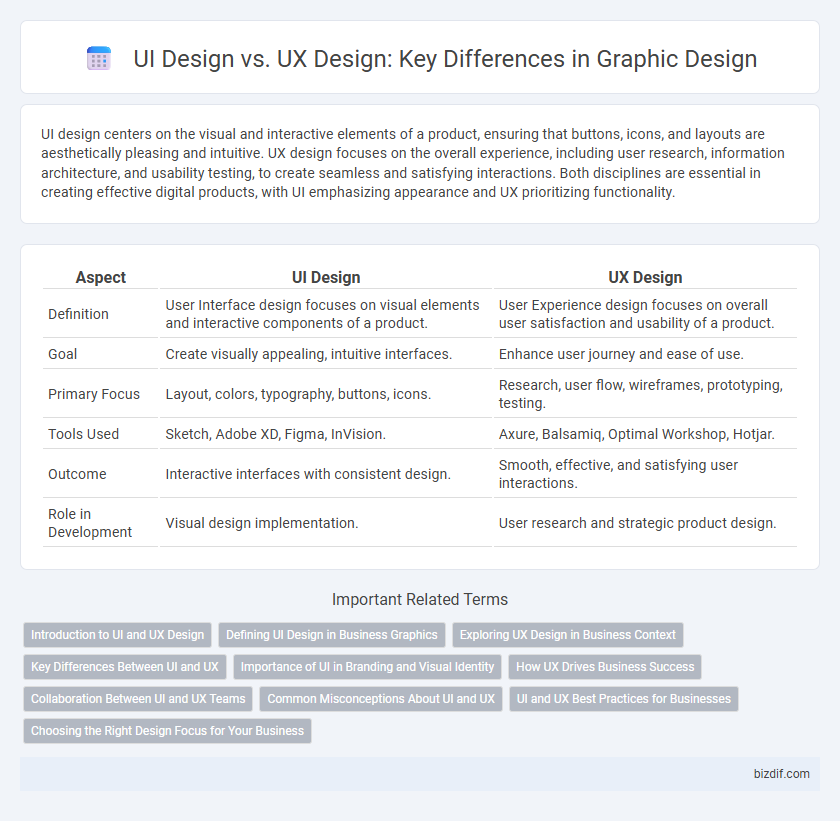UI design centers on the visual and interactive elements of a product, ensuring that buttons, icons, and layouts are aesthetically pleasing and intuitive. UX design focuses on the overall experience, including user research, information architecture, and usability testing, to create seamless and satisfying interactions. Both disciplines are essential in creating effective digital products, with UI emphasizing appearance and UX prioritizing functionality.
Table of Comparison
| Aspect | UI Design | UX Design |
|---|---|---|
| Definition | User Interface design focuses on visual elements and interactive components of a product. | User Experience design focuses on overall user satisfaction and usability of a product. |
| Goal | Create visually appealing, intuitive interfaces. | Enhance user journey and ease of use. |
| Primary Focus | Layout, colors, typography, buttons, icons. | Research, user flow, wireframes, prototyping, testing. |
| Tools Used | Sketch, Adobe XD, Figma, InVision. | Axure, Balsamiq, Optimal Workshop, Hotjar. |
| Outcome | Interactive interfaces with consistent design. | Smooth, effective, and satisfying user interactions. |
| Role in Development | Visual design implementation. | User research and strategic product design. |
Introduction to UI and UX Design
UI design focuses on the visual elements and interactive components of a digital product, ensuring an aesthetically pleasing and intuitive interface. UX design emphasizes the overall user experience, involving research, usability testing, and optimizing user flow to meet needs effectively. Both disciplines collaborate closely to create functional and engaging digital environments that enhance satisfaction and accessibility.
Defining UI Design in Business Graphics
UI Design in business graphics focuses on creating visually appealing and interactive interfaces that enhance user engagement and brand identity across digital platforms. It involves designing buttons, icons, typography, color schemes, and layout structures that facilitate intuitive navigation and seamless user interaction. Prioritizing aesthetics and consistency ensures that UI design drives higher conversion rates and reinforces professional brand perception.
Exploring UX Design in Business Context
UX design in a business context prioritizes user needs by optimizing product functionality and enhancing customer satisfaction, directly impacting conversion rates and brand loyalty. It integrates user research, usability testing, and interaction design to create seamless digital experiences that drive business growth and reduce churn. Emphasizing data-driven decisions and iterative improvements ensures that the UX design aligns with strategic business objectives and maximizes return on investment.
Key Differences Between UI and UX
UI design centers on the visual elements and interactive components of a digital product, including typography, colors, and buttons that enhance user engagement. UX design focuses on the overall experience and functionality, ensuring intuitive navigation, usability, and user satisfaction throughout the product journey. Key differences between UI and UX involve UI's role in aesthetics and layout, while UX prioritizes user research, wireframing, and the optimization of user flows.
Importance of UI in Branding and Visual Identity
UI design plays a crucial role in branding by establishing a consistent visual identity through color schemes, typography, and layout that resonate with the target audience. Effective UI design enhances user engagement and trust by creating intuitive and aesthetically pleasing interfaces that reflect brand values. Unlike UX design, which focuses on usability and overall user satisfaction, UI design directly influences the first impression and emotional connection users have with a brand.
How UX Drives Business Success
UX design prioritizes user needs and behaviors, leading to seamless interactions that enhance customer satisfaction and retention. By optimizing usability and accessibility, UX design reduces friction and increases conversion rates, directly impacting revenue growth. Well-executed UX design aligns business goals with user expectations, fostering brand loyalty and long-term success.
Collaboration Between UI and UX Teams
Effective collaboration between UI and UX teams ensures seamless integration of user experience strategies with visual design elements, enhancing overall product usability and aesthetics. UI designers translate user research insights provided by UX teams into intuitive interfaces, while UX professionals refine workflows based on UI feedback to optimize user engagement. Continuous communication and iterative prototyping between both teams drive innovation and deliver cohesive digital experiences.
Common Misconceptions About UI and UX
Common misconceptions about UI and UX design often confuse user interface with user experience, assuming UI is solely about aesthetics while UX encompasses all aspects of user interaction. Many believe that UX is just about usability, overlooking its emphasis on user emotions, satisfaction, and overall journey through the product. Understanding that UI is a subset of UX design clarifies that effective digital products require both visually appealing interfaces and seamless, intuitive experiences.
UI and UX Best Practices for Businesses
UI design emphasizes creating visually appealing and intuitive interfaces that enhance user interaction through clear layouts, consistent branding, and responsive elements. UX design focuses on improving overall user satisfaction by optimizing usability, accessibility, and information architecture to ensure seamless navigation and task completion. Businesses benefit by integrating UI and UX best practices, such as user research, prototyping, and iterative testing, to deliver engaging digital experiences that boost customer retention and conversion rates.
Choosing the Right Design Focus for Your Business
UI Design emphasizes the visual elements and interactive components that enhance user engagement, while UX Design prioritizes the overall user journey and satisfaction. Selecting the right focus depends on whether your business aims to improve aesthetic appeal and interface usability or optimize functionality and customer experience flow. A balanced integration of both disciplines often delivers the most effective digital solutions and drives higher user retention.
UI Design vs UX Design Infographic

 bizdif.com
bizdif.com